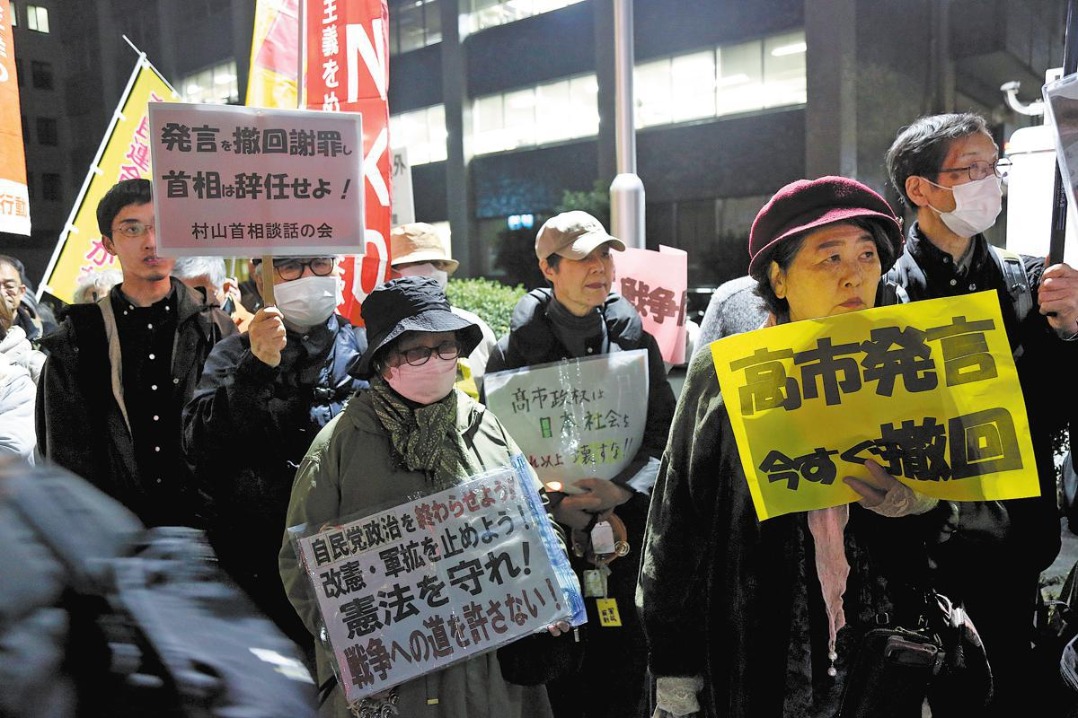Spirit of Shanghai Communique still crucial


China and the United States released the Shanghai Communique on Feb 28, 1972 following US President Richard Nixon's weekly visit to Beijing in February 1972, which began the normalization of bilateral ties and paved the way for establishing diplomatic relations in 1979. Over the past 50 years, bilateral ties, despite the many ups and downs, have been guided by the Shanghai Communique, and the following two communiques in 1979 and 1982.
The cooperation between the two countries has not only benefited the two peoples, but also contributed to regional and global economic growth, and helped maintain peace and stability. With the global landscape undergoing radical changes in recent times and Sino-US relations facing major challenges, reviewing the history of bilateral ties and weighing the importance of Nixon's visit to China and the Shanghai Communique are necessary for improving the most important bilateral relationship in the world.
Pragmatic cooperation despite huge differences
First, Nixon's visit to China and the signing of the Shanghai Communique paved the way for Sino-US pragmatic cooperation. Bilateral ties are based on common interests, and the convergence of interests is the fundamental force driving Sino-US relations. It is common interests that promote cooperation despite the huge differences between the two sides.
As a Republican politician, Nixon was rabidly anti-communist. Yet he set aside his prejudices to visit China, in order to safeguard the core interests of the US.
Nixon wanted to establish diplomatic ties with China to strengthen the US' global position, as it was mired in the Vietnam War and seemingly at a disadvantage in the US-Soviet rivalry for hegemony in the late 1960s and the beginning of the 1970s. As for China, it wanted to embrace open diplomacy and effectively cope with the security threat from the Soviet Union. Encouraged by the success of "ping-pong diplomacy" and then US national security adviser Henry Kissinger's visit to China in 1971, the US and China reached out to each other, which paved the way for Nixon's visit to China and changed the course of history.
And in the 50 years since then, the history of Sino-US relations has shown that cooperation benefits both sides while confrontation hurts both. For example, the Donald Trump administration exerted extreme pressure on China by launching a trade war in the hope of bringing China to its knees. But he ended up hurting the interests of US consumers and investors.
The lesson the trade war has taught both sides is that they should engage in pragmatic cooperation, find more common grounds, and explore more common interests, instead of being locked in confrontation.
Second, China and the US need to respect each other and handle bilateral relations in line with the Five Principles of Peaceful Coexistence. The US side has not acted in the "spirit of the contract" nor has it honored its commitments. On the contrary, the US is more interested in maintaining its global hegemony, still suffers from Cold War mentality, and continues to interfere in China's internal affairs including the Taiwan question, the South China Sea disputes, and Hong Kong, Xinjiang, Tibet and other issues.
These blatant interference in China's internal affairs and attack on its core interests are violations of the commitments it made in the Shanghai Communique. Not to mention they have not contributed to the healthy development of Sino-US relations. Whenever the US interferes in China's internal affairs, lectures China like a teacher or threatens to impose sanctions, it deals a blow to bilateral relations.
US should obey 'one-China' principle
Third, it's time China and the US found more common grounds while shelving their differences to work together to promote common interests and take measures to improve bilateral ties. When Nixon visited China, the two countries had been locked in a bitter confrontation for more than 22 years, and their positions on many issues were diametrically opposite. Yet they didn't avoid these contradictions during their talks.
The Shanghai Communique is an open and honest document, and explains the respective positions of China and the US on some issues, and deals with the differences head-on. It clearly states: "There are essential differences between China and the United States in their social systems and foreign policies." Yet the two sides agreed to establish relations on the basis of the Five Principles of Peaceful Coexistence without resorting to threat or force.
The concept of seeking common ground while reserving differences is still important for the healthy development of Sino-US relations. With the increase in China's comprehensive national strength, the structural contradiction between China and the US has become even more prominent, as is reflected in their vastly different social systems, values and traditions. These enormous differences will inevitably lead to different views on many regional and international issues. The key is how to handle the conflicts and differences, so as to continue working together for the benefit of the peoples of the two countries and beyond.
Fourth, the one-China principle espoused by the Shanghai Communique has been (and will be) the political foundation of Sino-US relations. During Nixon's visit, China and the US held detailed talks on the Taiwan question. Seeking common ground while shelving their differences to conduct pragmatic cooperation, the two countries reached an agreement. The US acknowledged that Chinese people on either side of the Taiwan Straits believe there is but one China and that Taiwan is a part of China. It is the core meaning of the "one-China principle" and "the Government of the People's Republic of China is the sole legal government of China".
The Taiwan question is the most sensitive aspect of Sino-US relations, involving China's core interest. That's why besides domestic political factors, the Taiwan question prevented China and the US from establishing formal diplomatic relations until 1979.
China established diplomatic relations with the US only after the latter accepted the "three principles for establishing diplomatic relations" proposed by the Chinese side. But in recent years, the US' stance on the "one-China principle" seems to be wavering. In fact, the US has taken measures to hollow Washington's "one-China policy", thereby undermining the political foundation of Sino-US relations and giving rise to confrontation.
US shouldn't break pledge on eschewing hegemony
Fifth, the Shanghai Communique also affirmed the importance of strengthening contacts and exchanges between the two peoples, and highlighted the need to facilitate people-to-people exchanges, and strengthen trade relations. Fifty years ago, it was extremely courageous of the Chinese side to agree to do so, given the global position of China at the time.
Yet in recent years, some anti-China forces in the US have been denying the importance of Nixon's strategy of engaging with China, and the US has taken measures to restrict people-to-people and cultural exchanges between the two countries. Not satisfied with that, the previous US administration even launched a trade war against China.
Such moves, needless to say, are a deviation from the commitments the US made in the Shanghai Communique.
Sixth, the anti-hegemonic stance taken by China and the US in the Shanghai Communique is still critically important. In the communique, the two sides expressly pledged that "neither should seek hegemony in the Asia-Pacific region and each is opposed to efforts by any other country or group of countries to establish such hegemony".
Over the past few years, however, the US has launched its Asia-Pacific rebalancing strategy and the Indo-Pacific strategy to ensure that it continues to play the "leading role" in the region. But by doing so, the US violated the commitment it made in the Shanghai Communique. In order to maintain its hegemony in the Asia-Pacific, the US has shifted the center of its strategy further eastward, increasing its military presence in the Western Pacific and strengthening its bilateral and multilateral military alliances with other countries in the Asia-Pacific region.
On the pretext of helping maintain the regional order and build a free and open Indo-Pacific region, the US has been pursuing its hegemonic agenda, threatening regional and global peace and stability.
The 50th year of the signing of the Shanghai Communique is of special significance, for it is a time to commemorate Nixon's historic visit to China and all the positive developments since then. Nixon's visit to China in 1972 changed the world and international relations.
But times have changed, so have perceptions. It is impossible for Sino-US relations to return to those uncertain but hopeful days. However, the spirit of seeking common ground while shelving differences and conducting pragmatic cooperation is not outdated. Instead, it has become increasingly necessary.
The competition and cooperation between China and the US have undergone qualitative changes, and the strategic game between the two sides has entered a new stage. And whether these developments will trigger a new Cold War has become a hot topic of discussion in political and economic circles. It is therefore imperative that the two sides shelve their differences and seek common ground to conduct pragmatic cooperation.
China and the US should also strengthen dialogue and communication with the aim of building a protective fence around bilateral ties, find ways to coexist peacefully, and gradually build a new type of future-oriented major-country relationship.
The author is deputy director of, and a senior fellow at the Institute of American Studies, Chinese Academy of Social Sciences. The views don't necessarily reflect those of China Daily.
If you have a specific expertise, or would like to share your thought about our stories, then send us your writings at opinion@chinadaily.com.cn, and comment@chinadaily.com.cn.


































